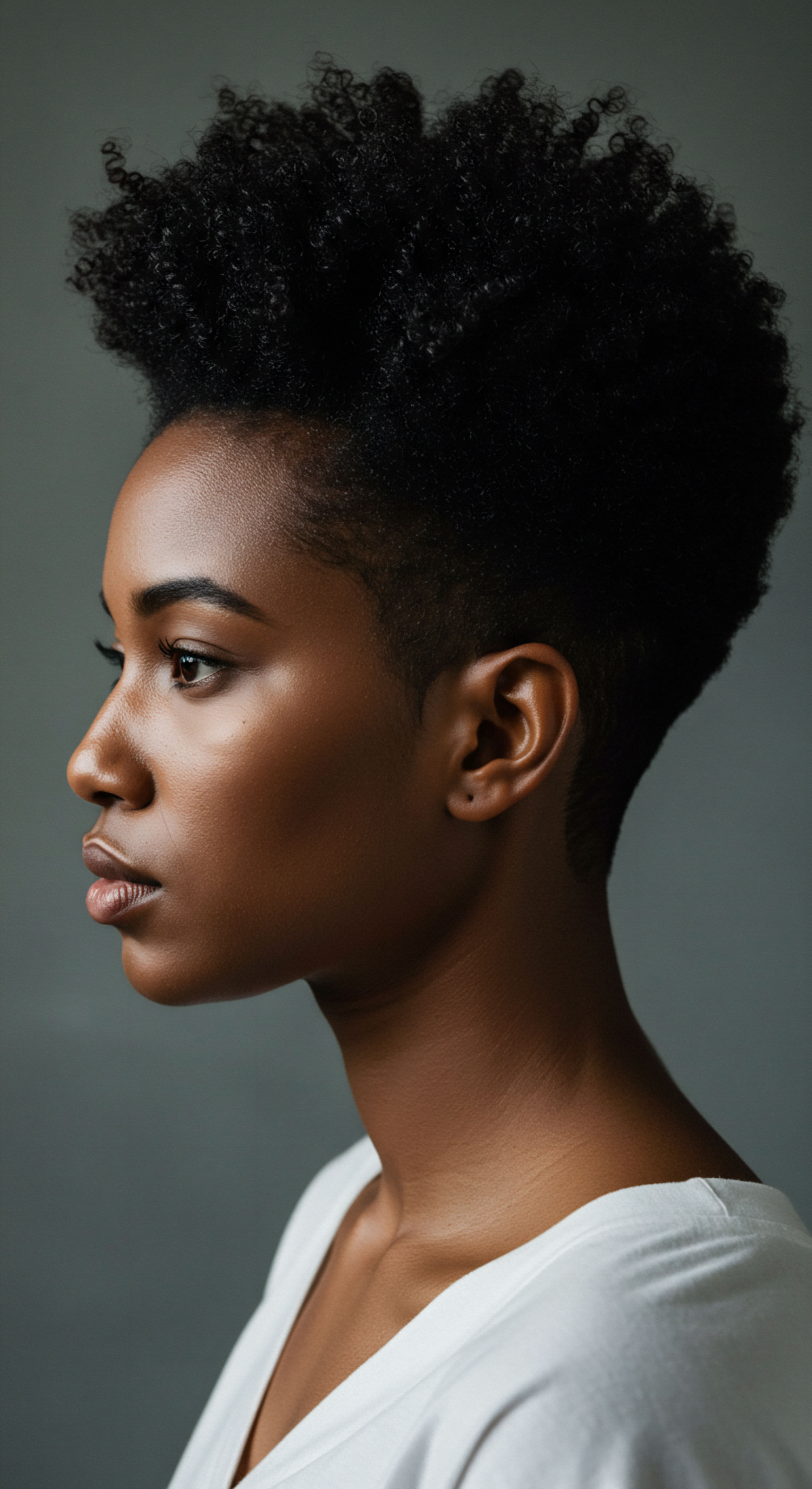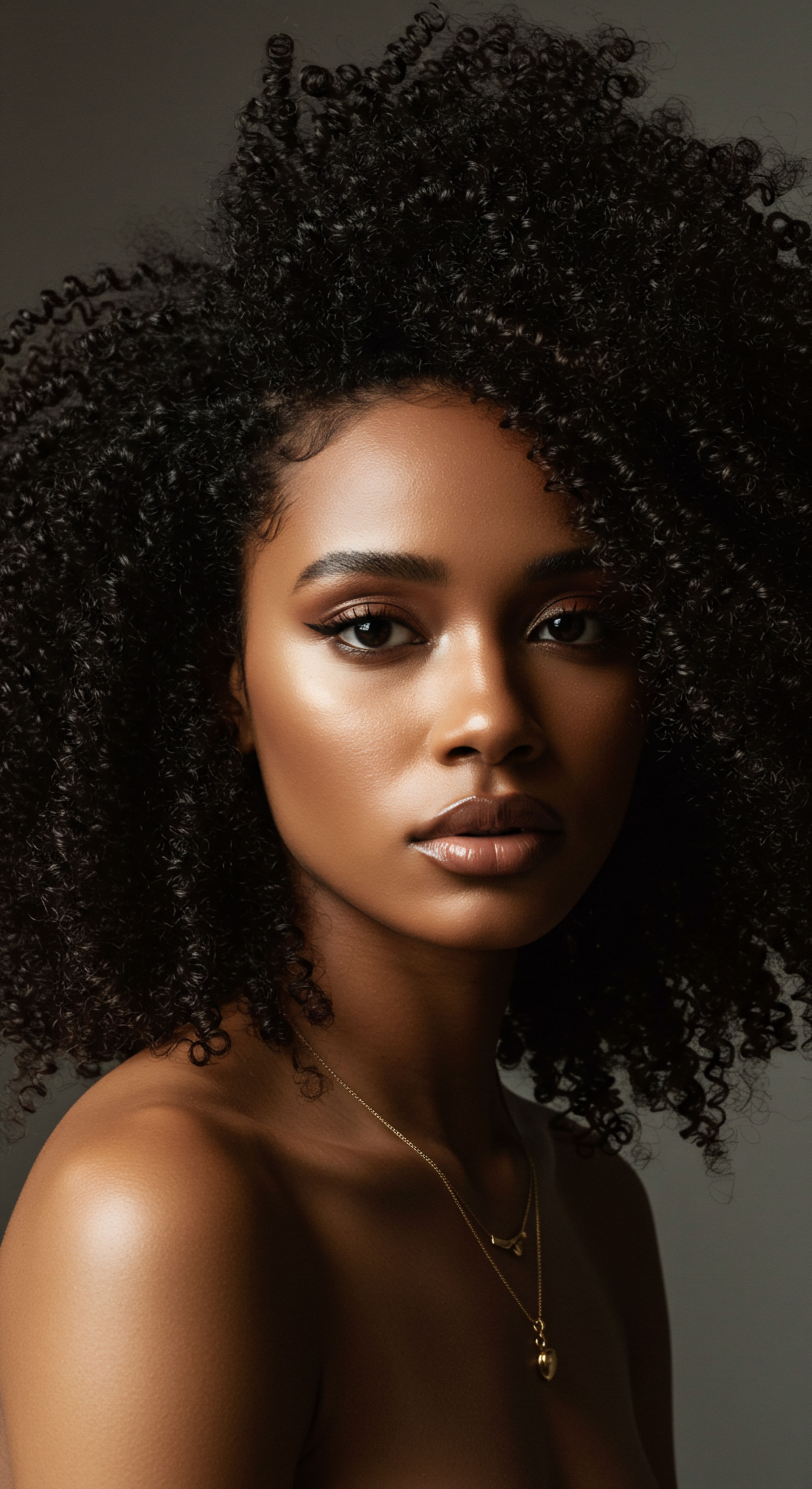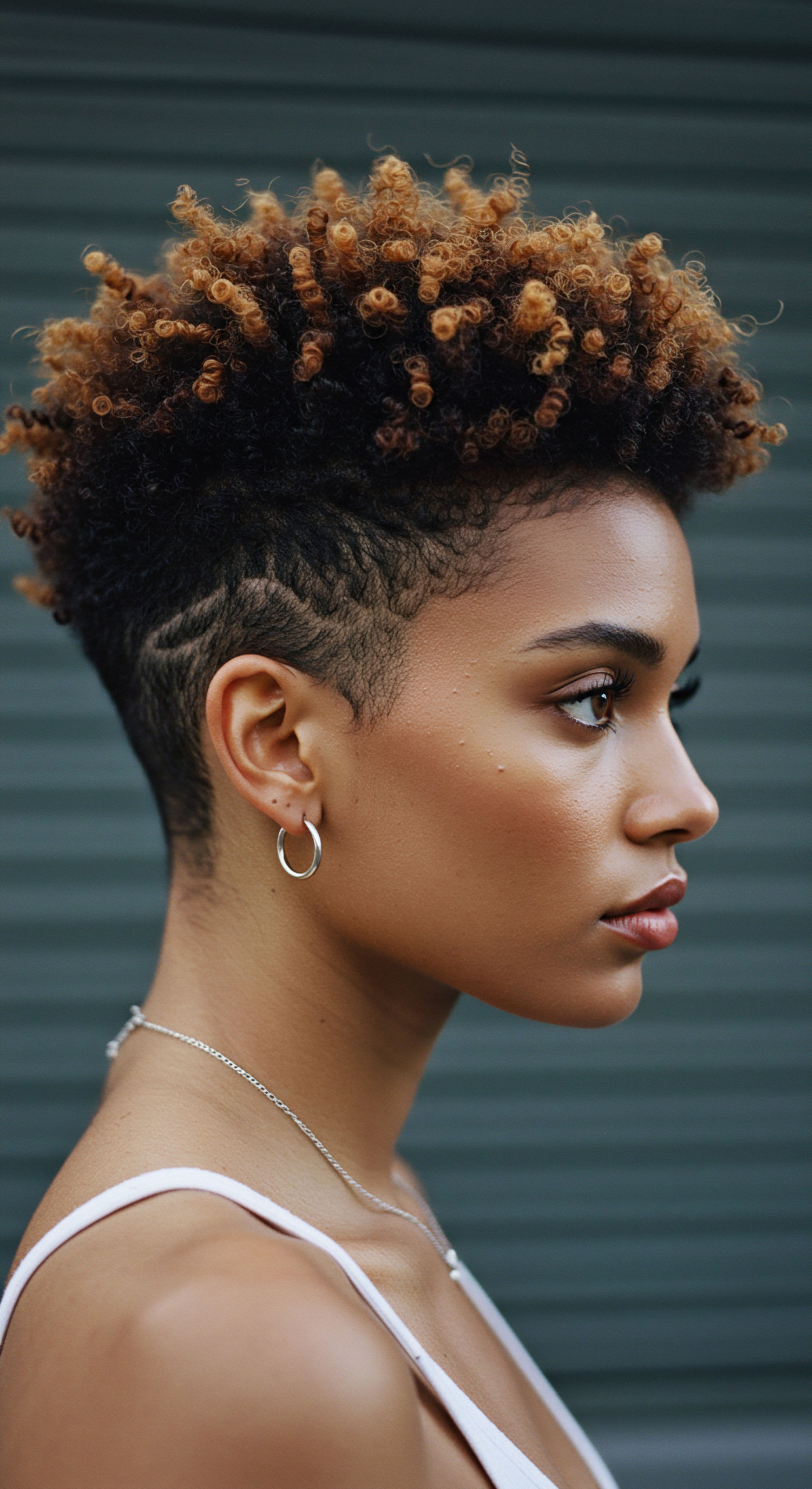
Roots
The story of textured hair, its strength, its spirit, and its inherent thirst, stretches back through countless generations, a silent yet powerful dialogue between ancestry and aspiration. We often find ourselves in modern beauty aisles, pondering serums and creams, yet the whispers of ancient practices hold keys to understanding our strands at their most fundamental level. This understanding begins not with a product, but with a reverence for hair’s deep past, a history where care was often a spiritual act, a communal bond, and a practical shield against the elements.
Consider the earliest expressions of hair care, long before chemical compositions dominated discussions. Across various pre-colonial African societies, hair was a symbol of identity, social standing, age, and even marital status. Elaborate styles were not merely aesthetic choices; they were intricate maps of belonging, communicating silent messages within communities. This profound connection meant hair was routinely washed, combed, oiled, and styled, often in communal settings, strengthening social ties.
The substances used were often derived directly from the earth ❉ natural butters, various herbs, and finely ground powders. These ingredients were not chosen arbitrarily; they were selected for their ability to protect, to adorn, and crucially, to maintain the hair’s vitality in diverse climates.
One might ponder, how did these early practices truly sustain moisture for textured hair, particularly given its unique structural characteristics? Textured hair, with its spiraled and often flattened elliptical shape, possesses a cuticle layer that tends to be more raised and prone to moisture loss compared to straighter hair types. This architectural reality means textured strands naturally shed water more readily, making effective hydration a constant consideration.
Our ancestors intuitively understood this, even without the benefit of modern microscopy. Their solutions, honed over millennia, centered on sealing in moisture and minimizing its escape.

What Ancient Knowledge Holds for Modern Hair?
The historical record reveals a remarkable consistency in the core principles of moisture retention. From ancient Egypt to various African communities, oils were central. Ancient Egyptians, for example, used almond and castor oils to nourish their hair, sometimes mixing them with honey and herbs to create conditioning masks.
These oils, rich in fatty acids, provided an occlusive layer, preventing water from evaporating from the hair shaft. This ancient wisdom points to a foundational truth ❉ oil acts as a barrier, a protective seal.
The application of such fatty substances was not solely for health; it also served a styling purpose. Analysis of mummified hair from ancient Egypt, dating back as far as 3,500 years ago, revealed a fat-based gel, likely composed of long-chain fatty acids such as palmitic acid, used to set hairstyles. This suggests a dual function for these historical concoctions ❉ providing both hold and hydration, a combination many modern textured hair products aim to achieve.
Early hair care was a blend of spiritual significance, social communication, and deep understanding of environmental needs.
Beyond oils, the strategic use of protective styles was paramount. Braids, twists, and various forms of coiling hair close to the scalp were not only culturally significant but also served a practical purpose ❉ reducing exposure to the elements and minimizing manipulation, thereby helping to preserve moisture. These styles, passed down through generations, effectively acted as natural humidors for the hair, allowing internal moisture to remain longer within the coiled structure.

Hair’s Microscopic Differences and Ancient Solutions
The inherent dryness often associated with textured hair, particularly Afro-textured hair, stems from its unique geometry. The tight coiling means that natural sebum, produced by the scalp, struggles to travel down the entire length of the hair shaft, leaving the ends particularly vulnerable to dryness. Ancient practices directly addressed this by applying external emollients. The application of oils and butters was a direct response to this structural reality, supplementing the hair’s natural lubrication system.
- Oil Therapy, a practice with centuries of history, aimed to strengthen hair, prevent split ends, and reduce breakage.
- Herbal Concoctions, often steeped in traditional medicine systems like Ayurveda, utilized plants like amla, bhringraj, and hibiscus for scalp nourishment and hair vitality.
- Protective Styles, such as braids and twists, offered a means to shelter hair from environmental stressors, minimizing moisture loss and mechanical damage.
This historical approach to hair care was holistic, considering the hair as part of a larger ecosystem of body and environment. It was about working with the hair’s natural tendencies, rather than against them, a lesson that continues to resonate with modern moisture rituals.

Ritual
Stepping from the echoes of ancient wisdom into the present, we find that the rhythms of hair care continue to shape our daily lives. The routines we cultivate, the products we select, the very movements of our hands through our hair, carry a resonance of practices perfected over generations. This section considers how those historical underpinnings translate into the contemporary moisture rituals that textured hair demands, moving beyond simple application to a deeper understanding of the “why” behind each gesture.
Modern moisture rituals for textured hair are not simply about applying a product; they are about creating an environment where the hair can thrive, mirroring the intentionality of historical practices. The susceptibility of textured hair to dryness, a characteristic noted in research, makes consistent hydration a paramount concern. This is where the concept of layering comes into play, a method that, while not explicitly named in ancient texts, certainly finds its conceptual roots in the multi-step historical applications of various substances.

How Do Layering Methods Echo Past Practices?
The Liquid, Oil, Cream (LOC) or Liquid, Cream, Oil (LCO) methods, widely popular today, represent a systematic approach to sealing moisture into the hair shaft. These techniques involve applying a water-based product (liquid), followed by an oil, and then a cream, or a cream before the oil. This layering directly parallels the ancient use of water or herbal rinses, followed by rich butters or oils.
The water provides the initial hydration, while the oil and cream create occlusive layers, slowing down the rate at which water escapes from the hair. This approach acknowledges the hair’s need for both internal hydration and external protection.
Consider the impact of humidity on hair. For textured hair, unlike straighter types, moisture often has positive effects, making it easier to comb and reducing breakage. This inherent response of textured hair to atmospheric moisture means that modern rituals aim to replicate or enhance a humid environment around the strands. The use of steam treatments, warm towels, or even simply applying products to damp hair, all serve to open the cuticle and allow for better absorption of hydrating agents, much like ancient applications might have benefited from the warmth of the sun or body heat.
Modern moisture methods, like LOC or LCO, reflect ancient layering principles for sustained hydration.
The choice of ingredients in modern moisture rituals also draws heavily from ancestral knowledge. Many contemporary hair care lines proudly feature shea butter, coconut oil, argan oil, and other plant-derived components that have been staples in African and other indigenous hair care for centuries. Shea butter, for instance, known for its rich emollient properties, has a long history of use in West African communities for skin and hair conditioning. These ingredients provide lipids that help to reinforce the hair’s natural barrier, reducing water loss.

What Role Does Consistency Play in Hair Health?
Consistency, a silent hero in any beauty regimen, gains particular prominence for textured hair. Just as ancient rituals were often daily or weekly affairs, modern moisture practices require regular attention. Afro-textured hair, in particular, loses moisture quickly after washing, necessitating frequent moisturization.
Recommendations often suggest washing textured hair weekly or every other week, with moisturization occurring as often as needed between washes. This consistent application of hydrating and sealing agents helps to mitigate the inherent dryness and maintain the hair’s suppleness.
Beyond the physical application, the ritual of hair care also provides moments of quiet self-care, a continuity with the communal grooming practices of the past. The act of detangling, conditioning, and styling can become a meditative practice, a connection to one’s heritage and personal well-being. This gentle handling is particularly important for textured hair, which can be more fragile when wet. Using wide-tooth combs or detangling brushes, alongside conditioning agents, reduces mechanical stress and breakage, preserving the hair’s integrity.
- Deep Conditioning treatments, performed weekly or bi-weekly, aid in moisture retention.
- Hot Oil Treatments, applied perhaps twice a month, promote moisture retention and can reduce split ends.
- Regular Detangling with appropriate tools helps prevent knots and minimizes breakage, particularly when hair is wet.
The transition from historical practices to modern rituals reveals a continuous quest for optimal hair health, adapting ancestral wisdom to contemporary understanding and product science. The essence of moisture ritual remains ❉ providing sustained hydration and protection for textured strands.

Relay
The historical journey of hair care for textured strands, from ancient ceremonial adornments to the nuanced routines of today, is not a simple linear progression. It is a complex relay, a handing off of wisdom across centuries, cultures, and scientific advancements. This segment explores the intricate interplay of historical practices, scientific understanding, and cultural context, revealing how modern moisture rituals for textured hair are deeply informed by this layered legacy. We seek to understand the deeper “why” behind the hair’s behavior and our response to it, moving beyond surface-level solutions to a holistic comprehension.
A striking observation in the scientific study of hair is the differing water absorption and desorption properties across hair types. Research indicates that tightly coiled African hair, when compared to Caucasian hair, demonstrates a lower capacity for moisture uptake. Despite this, Afro-textured hair generally possesses a higher overall lipid content—up to 2.5 to 3.2 times higher than European and Asian hair, respectively. This apparent paradox highlights a critical point ❉ while the hair may resist initial water absorption, its inherent lipid richness suggests a natural defense mechanism against rapid moisture loss, a characteristic our ancestors likely observed and supported through their practices.

What Does Hair’s Unique Structure Tell Us About Moisture?
The cuticle, the outermost layer of the hair shaft, plays a central role in moisture dynamics. For textured hair, the cuticle layers are often more lifted, contributing to increased porosity. This higher porosity means water can enter and leave the hair shaft more readily. This structural reality underscores the historical emphasis on occlusive agents like oils and butters.
These substances act as a physical barrier, coating the hair shaft to slow down the rate of water evaporation, effectively “sealing” in the moisture that has been absorbed. This is a direct echo of ancient Egyptian practices where fatty substances were applied to hair, not only for styling but also for protection.
Consider the broader context of environmental stressors. Historically, hair was exposed to harsh climates—intense sun, dry winds, or high humidity. Ancient communities developed practices that acted as a shield. Modern research confirms the detrimental effects of environmental factors on hair health.
Excessive UV exposure degrades keratin and strips hair of moisture, while fluctuating humidity causes frizz and unmanageability. The traditional use of head coverings, braids, and rich emollients provided a practical response to these challenges, reducing direct exposure and reinforcing the hair’s natural defenses.
The higher lipid content in Afro-textured hair suggests a natural defense against moisture loss, a property supported by historical oil applications.
The choice of specific botanicals in historical hair care also provides scientific validation for modern ingredients. For instance, ethnobotanical studies in Africa have identified numerous plant species used for hair care, with many having properties relevant to scalp health and hair growth. The Lamiaceae family, for example, is highly represented in African hair care plants, and many identified species also show potential as antidiabetic treatments when taken orally, hinting at broader systemic health connections. This suggests a deeper, perhaps unconscious, understanding of the interplay between internal wellness and external hair health.

How Do Historical Practices Inform Modern Product Development?
The modern textured hair care industry has, in many ways, come full circle, rediscovering and re-validating the efficacy of natural ingredients and traditional methods. The shift towards “clean beauty” and plant-based formulations directly mirrors the historical reliance on ingredients derived directly from nature. This is not merely a trend; it is a recognition of the wisdom embedded in ancestral practices.
The emphasis on gentle cleansing and conditioning, often with sulfate-free shampoos and rich conditioners, reflects the understanding that textured hair requires a delicate approach to preserve its natural oils and moisture. Historically, harsh cleansers were not available, and hair was likely cleansed with gentler, often clay-based or herbal washes. This gentler approach minimized stripping the hair of its protective lipids.
| Hair Type Afro-textured |
| Average Lipid Content (Relative) Highest (2.5-3.2x European/Asian) |
| Moisture Retention Tendency Low initial water uptake, but high lipid content aids retention |
| Hair Type European |
| Average Lipid Content (Relative) Lower |
| Moisture Retention Tendency Higher hydration levels, lower permeability |
| Hair Type Asian |
| Average Lipid Content (Relative) Lower |
| Moisture Retention Tendency Lower permeability |
| Hair Type Understanding these inherent differences guides tailored moisture rituals. |
A compelling data point highlighting the effectiveness of moisture for textured hair comes from recent studies on hair breakage. Single fiber tensile tests demonstrate that occlusive treatments, those that seal moisture, can maintain higher hair moisture levels and significantly reduce premature fracturing of textured hair when stretched. For instance, one study observed lower levels of premature breakage at 80% relative humidity compared to 40% relative humidity, underscoring the protective role of hydration. This scientific validation provides a powerful backing for the age-old practice of keeping textured hair moisturized.
The societal implications of hair care also cannot be overlooked. In pre-colonial Africa, hair was a powerful symbol of status and belonging. During periods of enslavement, hair was often forcibly cut, serving as a tool of dehumanization and cultural erasure.
The resurgence of natural hair movements in modern times, embracing ancestral styles and textures, is a profound act of reclaiming identity and heritage. This cultural context imbues modern moisture rituals with a significance beyond mere aesthetics; they become acts of self-affirmation and connection to a rich past.
- Scientific Studies on botanical oils confirm their benefits for scalp health and hair strength, validating traditional remedies.
- Research on Hair Porosity explains why textured hair benefits from layering and occlusive agents to counter moisture loss.
- Modern Protective Styles, rooted in ancient techniques, continue to offer a practical solution for minimizing damage and retaining length.
Thus, the relay of hair care wisdom continues, each generation building upon the last, blending time-honored practices with scientific discovery to create moisture rituals that truly serve the unique needs of textured hair.

Reflection
As we consider the journey from ancient hair practices to our current moisture rituals for textured hair, a quiet realization settles ❉ the path forward is not a departure from the past, but a deeper listening to its enduring lessons. The ancestral wisdom, born of intimate observation and sustained connection to the earth, continues to whisper truths that science now echoes. Our modern tools and formulations may be new, yet the fundamental needs of textured hair remain the same—hydration, protection, and gentle regard. This continuity speaks to something beyond mere aesthetics; it points to a profound relationship with our hair as a living extension of our heritage, a crown we carry with pride and informed care.

References
- McCreesh, N. C. Gize, A. P. & David, A. R. (2011). Ancient Egyptian Hair Gel ❉ New Insight into Ancient Egyptian Mummification Procedures through Chemical Analysis. Journal of Archaeological Science, 38(12), 3432–3434.
- Nguenang, R. F. Ngounou, F. N. Ndam, L. M. & Kemeze, T. S. (2024). Cosmetopoeia of African Plants in Hair Treatment and Care ❉ Topical Nutrition and the Antidiabetic Connection? Diversity, 16(2), 96.
- Roseborough, I. E. & McMichael, A. J. (2009). Hair Care Practices in African-American Patients. Seminars in Cutaneous Medicine and Surgery, 28(2), 103–108.
- Wong, N. Williams, K. Tolliver, S. & Potts, G. (2025). Historical Perspectives on Hair Care and Common Styling Practices in Black Women. Cutis, 115(3), 95–99.
- Mcmullen, R. L. Gillece, T. & Schiess, T. (2021). Physicochemical Properties of Textured Hair. Journal of Cosmetic Science, 72(6), 711–731.
- Adlam, D. Jones, C. & Adlam, D. (2024). Hair Moisturization Claims 101. TRI Princeton.
- Dawson, W. R. (1927). The Egyptian Mummification. The Journal of Egyptian Archaeology, 13(3/4), 167-174.
- Sybille Rosado. (2003). Black Women’s Hair as a Site of Resistance and Identity Formation. Journal of Black Studies, 33(5), 603-617.
- McCreesh, N. C. Gize, A. P. & David, A. R. (2011). Ancient Egyptian Hair Gel ❉ New Insight into Ancient Egyptian Mummification Procedures through Chemical Analysis. Journal of Archaeological Science, 38(12), 3432–3434.
- Barba, C. Martí, M. Manich, A. M. Carilla, J. Parra, J. L. & Coderch, L. (2010). Water Absorption/Desorption of Human Hair and Nails. Thermochimica Acta, 503-504, 33-39.